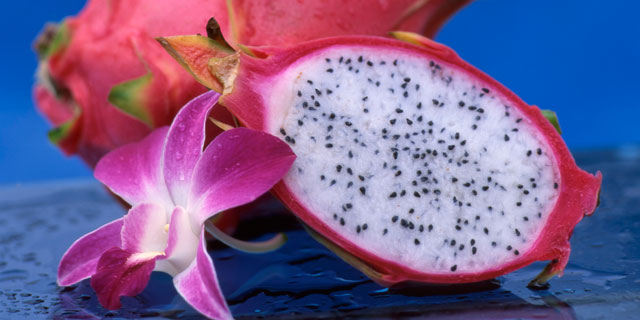Pitaya, also known as wild strawberry pear and dragon fruit, is an exotic fruit with hot pink skin and little green scales. On the inside this fruit is mildly sweet, with a creamy white or rosy flesh speckled with black seeds. An extremely beautiful fruit, it is what’s on the inside that counts – and that is a whole lot of nutrition.
Pitaya is rich in immune system boosting Vitamin C; B Vitamins including B2, which aid in recovery and healing whether it be from the common cold or a tough workout; and a host of antioxidants that help your body rid itself of free radicals. Calcium, iron, and fiber, along with 100 grams of this sweet fruit clocking in at just 60 calories, rounds out the reasons pitaya should be your new fave.
How do I pick the best pitaya?
To choose a ripe piece of pitaya first look at the skin. The rind and scales should be brightly hued, uniform in color, and free of any browning or dry spots. The fruit should be heavy for its size and yield to gentle pressure. Skip any fruit that is too soft, has dark blotches, or waning color as this indicates overripeness. If you can only find firm fruit no worries, pitaya can be ripened at home at room temperature. Since dragon fruit is highly perishable, check your fruit every day to ensure it doesn’t become overly ripe before you can enjoy it!
What can I make with pitaya?
With its mild, sweet taste, pitayas are often used in desserts. Combine fresh dragon fruit and lime for a refreshing sorbet, add to cake batter for a twist, or use to make jams and jellies for a layer cake. From ice pops and muffins to smoothies and cocktails, pitaya pairs perfectly with them all. Of course, fresh pitaya in a fruit salad or scooped out with a spoon and enjoyed on its own is a healthy sweet treat you shouldn’t resist!
To prep pitaya first run under cool water and pat dry. Using a sharp knife cut through the rind until you have two equal pieces. The flesh may vary from pink to creamy white, both riddled with seeds. Both are delicious, and can be easily scooped out with a spoon or melon baller. Once scooped out, the flesh can be sliced and diced as desired. For a nice display hold onto the rinds and use them as bowls when serving fruit!
Pitaya may look and feel hearty but it is actually quite fragile so keep a close eye on it. Ripe pitaya will remain fresh and delicious for up to three days. Unripened picks can be left out at room temperature for a few days until ripe and ready to eat!
Recipes to try include: Green Power Smoothie (sub pitaya for kiwi), Coconut Passion Pops (sub pitaya for passion fruit), and Melon y Carambola con Crema de Limón (sub pitaya for star fruit).


![Making Mealtime Matter with La Familia: Easy Sofrito [Video]](https://thelatinkitchen.com/wp-content/uploads/2015/10/sofrito-shutterstock__0-500x383.jpg)
![Easy Latin Smoothies: Goji Berry Smoothie [Video]](https://thelatinkitchen.com/wp-content/uploads/2015/12/goji_berry-shutterstock_-500x383.jpg)
















![Fun and Fast Recipes: Fiesta Cabbage Salad [Video]](https://thelatinkitchen.com/wp-content/uploads/2015/11/fiesta_cabbage_slaw-shutterstock_-500x383.jpg)









